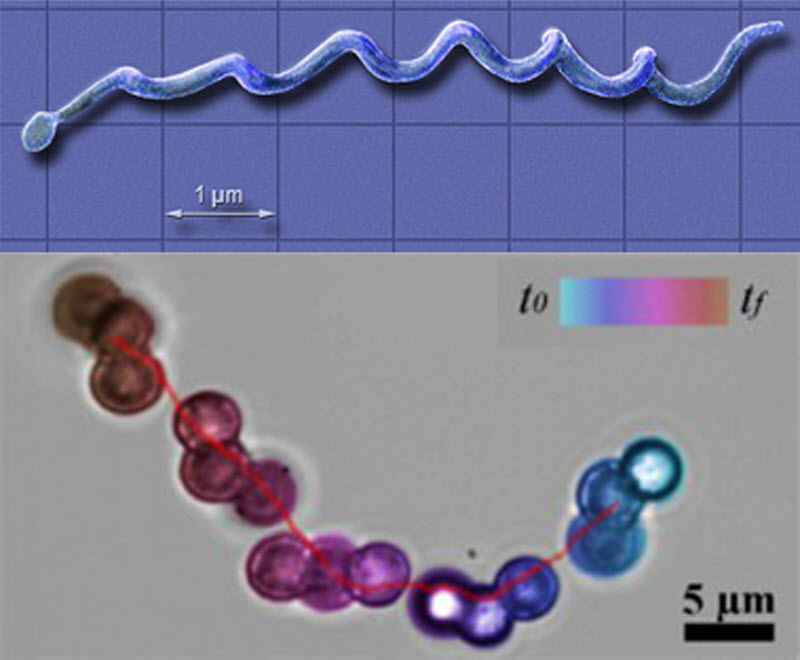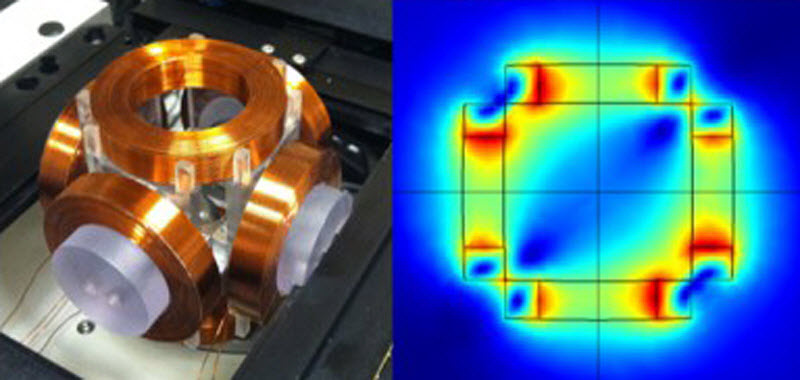‘Microswimmer’ robots to drill through blocked arteries within four years
June 30, 2015

Drexel’s microswimmer robots (bottom) are modeled, in form and motion, after spiral-shaped Borrelia burgdorferi bacteria (top), which cause Lyme Disease (credit: Drexel University)
Swarms of microscopic, magnetic, robotic beads could be used within five years by vascular surgeons to clear blocked arteries. These minimally invasive microrobots, which look and move like corkscrew-shaped bacteria, are being developed by an $18-million, 11-institution research initiative headed by the Korea Evaluation Institute of Industrial Technologies (KEIT).

Drexel engineers are able to control the movement of their micro-swimmer robots using magnetic fields (visual representation at right) generated by an electromagnetic device (left) (credit: Drexel University)
These “microswimmers” are driven and controlled by external magnetic fields, similar to how nanowires from Purdue University and ETH Zurich/Technion (recently covered on KurzweilAI) work, but based on a different design.
Instead of wires, they’re made from chains of three or more iron oxide beads, rigidly linked together via chemical bonds and magnetic force.
The beads are put in motion by an external magnetic field that causes each of them to rotate. Because they are linked together, their individual rotations cause the chain to twist like a corkscrew and this movement propels the microswimmer.
The chains are small enough — the nanoparticles are 50–100 nanometers in diameter — that they can navigate in the bloodstream like a tiny boat, Fantastic Voyage movie style (but without the microscopic humans) via a catheter to navigate directly to the blocked artery, where a drill would clear it completely.
Drilling through plaque
The inspiration for using the robotic swimmers as tiny drills came from the Borrelia burgdorferi bacteria (shown above), which causes Lyme’s Disease and wreaks havoc inside the body by burrowing through healthy tissue. Its spiral shape enables both its movement and the resultant cellular destruction.
By controlling the magnetic field, a surgeon could direct the speed and direction of the microswimmers. The magnetism also allows for joining separate strands of microswimmers together to make longer strings, which can then be propelled with greater force.
Once flow is restored in the artery, the microswimmer chains could disperse and be used to deliver anti-coagulant medication directly to the effected area to prevent future blockage. This procedure could supplant the two most common methods for treating blocked arteries: stenting and angioplasty. Stenting is a way of creating a bypass for blood to flow around the block by inserting a series of tubes into the artery, while angioplasty balloons out the blockage by expanding the artery with help from an inflatable probe.
“Current treatments for chronic total occlusion are only about 60 percent successful,” said MinJun Kim, PhD, a professor in the College of Engineering and director of the Biological Actuation, Sensing & Transport Laboratory (BASTLab) at Drexel University.
“We believe that the method we are developing could be as high as 80–90 percent successful and possibly shorten recovery time. The microswimmers are composed of inorganic biodegradable beads so they will not trigger an immune response in the body. We can adjust their size and surface properties to accurately deal with any type of arterial occlusion.” Kim’s research was recently reported in the Journal of Nanoparticle Research.
Mechanical engineers at Drexel University are using these microswimmers as a part of a surgical toolkit being assembled by the Daegu Gyeongbuk Institute of Science and Technology (DGIST).
Researchers from other institutions on the project include ETH Zurich, Seoul National University, Hanyang University, Korea Institute of Science and Technology, and Samsung Medical Center. DGIST anticipates testing the technology in lab and clinical settings within the next four years.
BAST Lab at Drexel University | Demonstration of Achiral microwimmers translational swimming
BAST Lab at Drexel University | Multiple robot control of 3 bead achiral microswimmers
Absbract of Self-assembly of robotic micro- and nanoswimmers using magnetic nanoparticles
Micro- and nanoscale robotic swimmers are very promising to significantly enhance the performance of particulate drug delivery by providing high accuracy at extremely small scales. Here, we introduce micro- and nanoswimmers fabricated using self-assembly of nanoparticles and control via magnetic fields. Nanoparticles self-align into parallel chains under magnetization. The swimmers exhibit flexibility under a rotating magnetic field resulting in chiral structures upon deformation, thereby having the prerequisite for non-reciprocal motion to move about at low Reynolds number. The swimmers are actuated wirelessly using an external rotating magnetic field supplied by approximate Helmholtz coils. By controlling the concentration of the suspended magnetic nanoparticles, the swimmers can be modulated into different sizes. Nanoscale swimmers are largely influenced by Brownian motion, as observed from their jerky trajectories. The microswimmers, which are roughly three times larger, are less vulnerable to the effects from Brownian motion. In this paper, we demonstrate responsive directional control of micro- and nanoswimmers and compare their respective diffusivities and trajectories to characterize the implications of Brownian disturbance on the motions of small and large swimmers. We then performed a simulation using a kinematic model for the magnetic swimmers including the stochastic nature of Brownian motion.